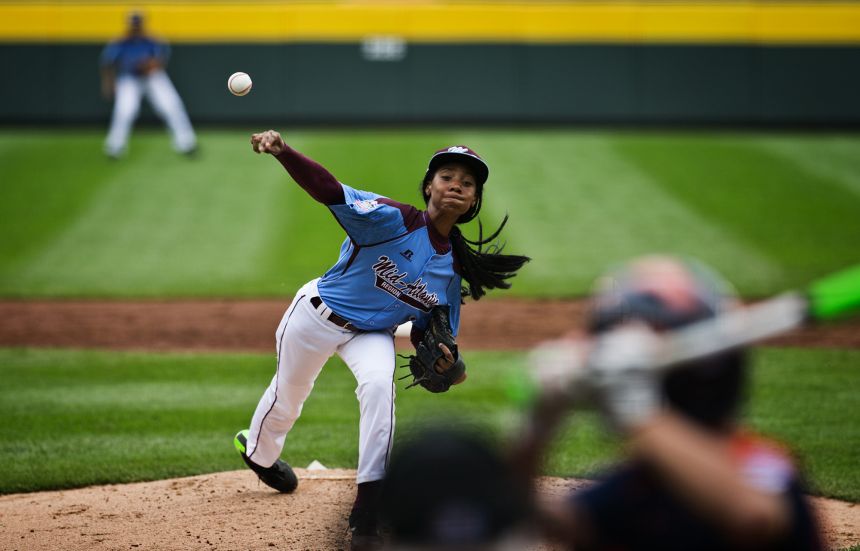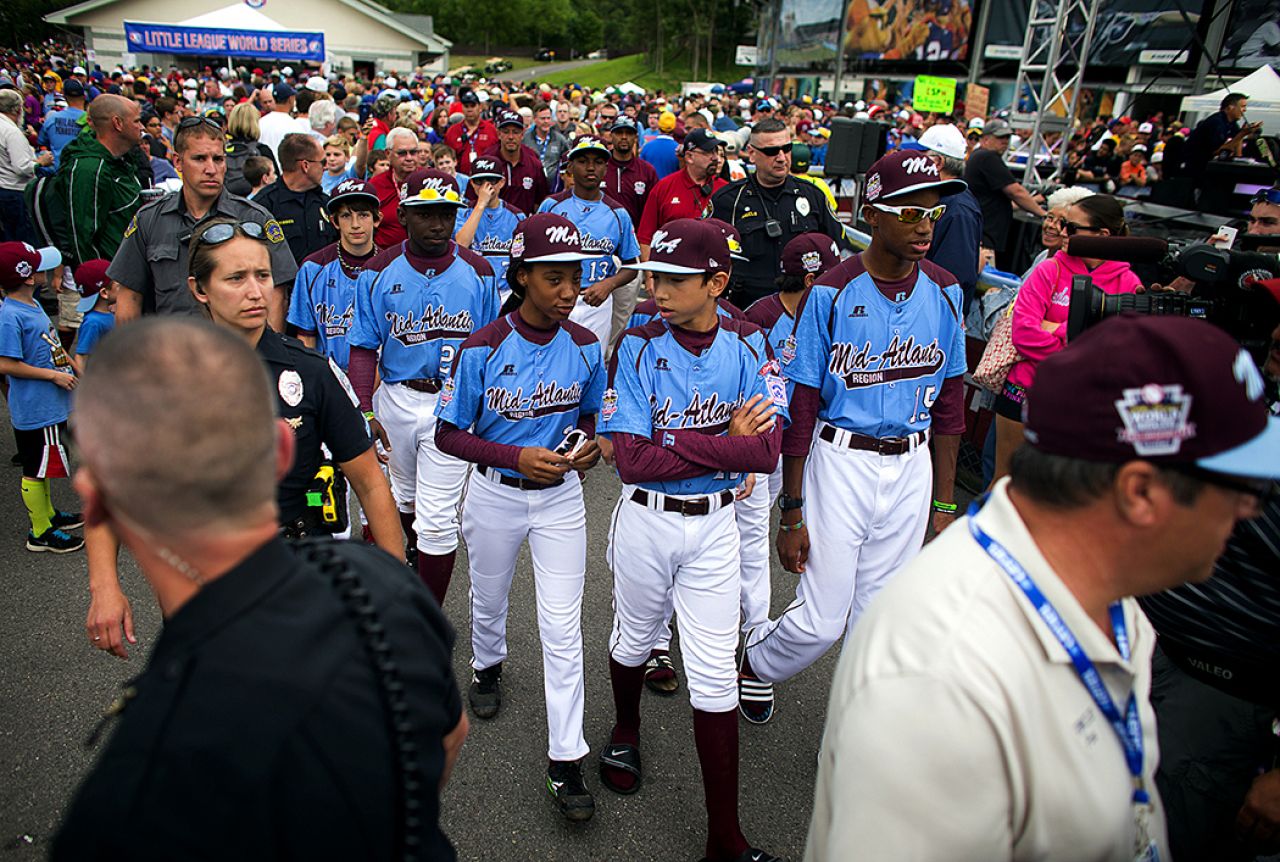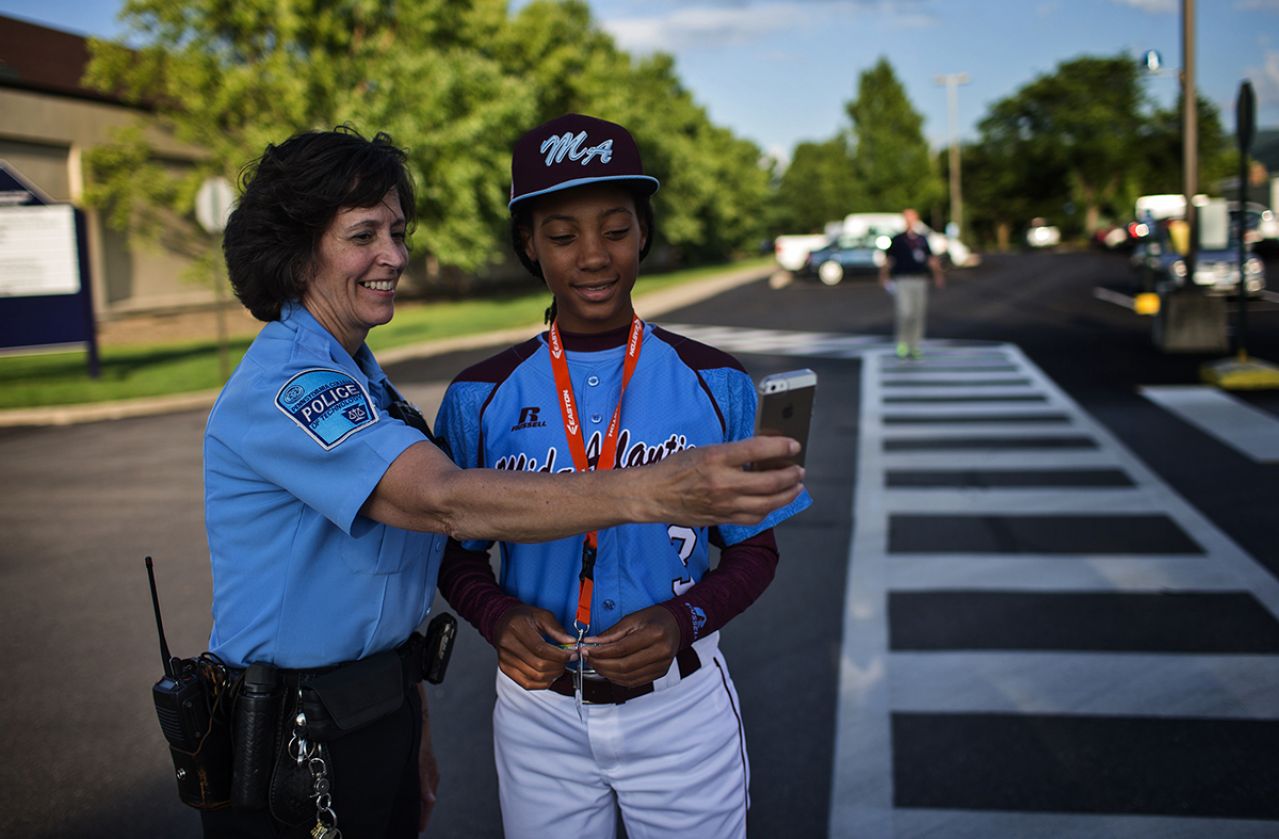January 18, 2024
Gamechanger: LLWS Legend Mo’ne Davis isn’t done

In 2014, Mo'Ne Davis earned the first pitching victory for a girl at the Little League World Series as she led her team from Philadelphia to the U.S. semifinals of the tournament.
Credit: Sean Simmers / PennliveSOUTH WILLIAMSPORT, Pa. — It was August 2014, and Mo’ne Davis stayed wide awake as her teammates napped on the ride back to Philadelphia from the Little League World Series.
She’d lived a lifetime in six days, and the trip served as her first opportunity to reflect on a journey that included her groundbreaking victory as a starting pitcher — the first for a girl at the LLWS — during the Taney Dragons’ run to the U.S. semifinals of the tournament.
Now, she thought, as she watched bucolic Pennsylvania roll by, it’s over.
She was wrong.
The frenzy only escalated when Davis stepped off the bus and into a parade on Broad Street. Cameras, screaming fans, everybody wanting an autograph. They were all there. The post-tournament tour included meetings with then-President Barack Obama and conversations, plural, with Kobe Bryant.
This year will mark the 40th anniversary of girls playing at the Little League World Series, and the 50th of the Little League Softball World Series.
But Davis’ appearance in the LLWS was a game changer. The attention she drew inspired others – four girls have followed her to South Williamsport – and her team has been something of a beacon to inner-city leagues.
A decade after her magical run, the tumult has finally settled for Davis, now a Columbia University graduate student working toward a master’s degree in sports management. She has plenty of ideas for her next groundbreaking adventure: expanding professional women’s sports in her community.
“In 10 years from now, I will be adding a WNBA team and NWSL team to Philly,” Davis said. “I want to really be able to look back, just enjoy the journey, and realize how hard I worked for that to happen.”
Cover story
Davis’ story began where it gained steam: on a baseball field.
Steve Bandura, founder and coach of South Philadelphia’s Anderson Monarchs, was dragging the infield on a tractor when he saw a 7-year-old Davis playing catch with her brothers in left field. He approached her and asked if she’d be interested in joining his newly created basketball team. Within a week, Davis was at practice.
“She’s always been the same person she is today,” Bandura said. “You can tell she’s pretty humble. She’s a pretty humble kid. She’s a pretty competent kid, and she’s never afraid to try new things.”
It didn’t matter to Davis that she was the only girl in Bandura’s program, the same way it didn’t matter when she stepped into a batter’s box for the first time, never having swung a bat in her life. In her first trips to the plate, opponents questioned who the little boy was with hot pink, Jennie Finch batting gloves strapped to his wrists, to which Bandura replied, “No, that’s a girl.”
Soon enough, they’d know Davis’ name all too well, defining herself as one of the city’s most dominant players by the age of 10. By the time she was 12, Davis booked the Dragons a place at the LLWS after tossing a three-hit shutout against Delaware.
For her next start, she was leading her Philly team again – now representing the Mid-Atlantic at the Little League World Series. The result? A milestone for Little League and girl athletes everywhere. Davis allowed just two hits in an opening-round 4-0 win over South Nashville, jogging off the mound with a no-big-deal smile after her last strike out.
“It didn't really hit until after the game because they give you a little press conference and then social media was blowing up,” Davis said. “And then you hear about the numbers. There's millions of people watching, which doesn't register to you while you're on the field because you're just playing baseball. It just kept going.”

Mo'ne Davis and teammate Jared Sprague-Lott walk through a throng of people to an interview with ESPN after Davis' 4-0, two-hit victory at the Little League World Series on Aug. 15, 2014.
Credit: Sean Simmers / PennliveDid it ever. She then appeared on the cover of Sports Illustrated after Taney’s second-round victory over Texas.
Davis was playing sting pong — a game that consisted of hitting a ping-pong ball as hard as she could into an opponent’s back, and vice versa — when a communications staffer asked if she’d be interested in a brief interview with the magazine. Davis obliged, and, two days later, the same staffer returned with a stack of copies, all of which included her image and a headline that read “MO’NE: Remember her name. As if we could ever forget.”
“That was something I never imagined,” Davis said. “And I didn’t think it was going to happen because it was just a five-minute interview. (I thought), ‘Like it’s only going to be another page or whatever,’ and then opening it and seeing the four pages and pictures, I thought it was very cool — like super cool to me.”
Even after the end it didn’t end. When Davis returned to Philadelphia following a 6-5 loss to Chicago’s Jackie Robinson West Little League that knocked her team out of the tournament, her national recognition only continued to grow.
Over the following months, Davis read beside Michelle Obama at the national Christmas tree lighting ceremony. She sat courtside at a Golden State Warriors game and met NBA superstars LeBron James, Kevin Durant and Steph Curry.
Davis struggled to find words as Bryant, another Philadelphia native, informed her over the phone that he and his two daughters had watched all of her games.
“They were just telling me how they were sitting in front of their TVs, watching and cheering for me, which is something that I never thought would happen, considering I looked up to all these athletes growing up and I got to see them on TV all the time,” Davis said. “Now, the roles were reversed.”
Lasting impact
Ten years after Davis’ tournament, four more female participants have etched their names in the history books, and 22 girls total have taken the field since 1984. Girls playing at South Williamsport has gone from a rarity to an almost annual tradition.
In 2021, Ella Bruning, a catcher from Abilene, Texas, became the first girl to record a hit in the tournament since Davis.
A starstruck Bruning strapped on her gear, got in her crouch behind home plate, and hauled in a curveball from Davis during a ceremonial first pitch before Abilene’s 2-1 second-round victory over Toms River, N.J.
“It’s always great to see more girls getting into baseball,” Davis said in August during a separate visit to the tournament last August. “I felt like growing up I was always the only one, so it’s nice to see. I think this is like the fourth consecutive year with a girl playing (in the LLWS). So it’s always cool to see the sport grow. And I know there’s a lot more girls out there that are playing, so it’s always cool just to see how far this game has grown since 2014.”
32%
of Little League baseball and softball participants are female, and softball participation is up 8% from 2018 to 2023
As it stands, 32% of Little League baseball and softball participants are now female. The vast majority of those girls play softball, which has seen an 8% increase in participation from 2018 to 2023.
Davis’ impact has extended further than the diamond. Jessica Mendoza, the first woman to serve as an analyst for nationally televised MLB games, said Taney’s deep run in 2014 was the “reason why” she “wanted to (cover) Little League after that.”
“The reality is that women have been doing things like Mo’ne was doing, they just weren’t doing it when competing with boys or men,” Mendoza said.
“I think at that time, it was having to prove it with the boys to show that it meant something. You can go back to Billie Jean King and Bobby Riggs, if you want. Billie Jean could do all the things she was doing at Wimbledon, but it wasn’t until she beat Bobby that people were like, ‘OK, maybe women can do some stuff.’”
Players of color
She may not have noticed it then, but Davis also was part of a historic year for athletes of color in South Williamsport, one that hasn’t been duplicated since. Taney and the Jackie Robinson West team that beat the Dragons were each predominately made up of Black players.
Bandura used the attention that followed for good when he rented a 1940s-era bus and took the Anderson Monarchs on a 4,500-mile trip through the Deep South, where Davis and the team played games, visited historic sites and met people involved in the civil rights movement.
“It’s fulfilling when the young kids go out there and you have an all-Black inner city team from South Philly playing against suburban teams and then winning a championship, that’s fulfilling,” Bandura said. “But the most fulfilling part of it is to see them go on and have career aspirations and want to make a difference in the community.”
Unfortunately, a decade later, a predominantly Black, American baseball team has yet to return to the LLWS.
That tracks with what’s happening elsewhere in the sport. According to a report published by the Institute for Diversity and Ethics in Sports at Central Florida, Black players accounted for just 6.2% of the MLB opening day rosters in 2023, a decline from the record low of 7.2% the season before.
Did Taney’s rise to national prominence, through a historic tournament and Davis’ fame, actually change anything for inner-city baseball programs?
“Should it have? Absolutely,” Bandura said. “It should have been a huge wake-up call, and a lot of people talked about it afterwards, but nothing has really gotten done. Since then, it’s just been a lot of talk … and never really attacking what the issue is and has always been — there just aren’t programs for these kids to participate in.”
What was once a sport that rose in popularity largely thanks to street games such as stickball, baseball has lost a spark among inner-city communities. Bandura said the decline began with the collapse of independent play, such as sandlot and pickup games, and has only gone downhill with the development of suburban academies and showcases.
The problem, Bandura argued, is systemic and can likely only be fixed with the attention of MLB and its clubs. Donating gloves and bats to less-fortunate kids may feel good, but there isn’t much use in equipment if the kids on the receiving end don’t have anywhere to use them.
“At the rate this is going now, there will be no baseball in the city in 15 years,” Bandura said. “And not under duress, there’s basically no baseball in the inner city now.”
Davis may not have all the answers to solve these issues, but her journey has served as evidence that inner-city athletes can thrive if the programs are available to them.
The next chapter
When all the noise settled, from baseball games to parades to courtside basketball games to White House visits, Davis closed her eyes and breathed — all the memories, all the emotions, driving her toward her ultimate purpose.
Along her path, Davis has played college softball at Hampton University, graduated with a degree in journalism, and served as a production intern with the Los Angeles Dodgers. When she wraps up her master’s degree at Columbia, Davis plans to begin her next chapter and make an even more significant impact on the sporting community.
Davis has ambitions to continue using her past, present and future to speed the growth of women’s sports — specifically in her hometown.
“There’s going to be so many more avenues and so many more outlets for girls to play sports because it’s going to keep expanding,” Davis said. “You’re going to see it in a lot more places and hopefully that just gives girls that courage, that confidence and joy because they see people that look like them playing a professional sport and they want to do the same.”

Police woman Crystal Follmer takes a selfie with Mo'ne Davis during the Little League World Series Grand Slam Parade in Williamsport, Pa., on Aug. 13, 2014.
Credit: Sean Simmers / Pennlive